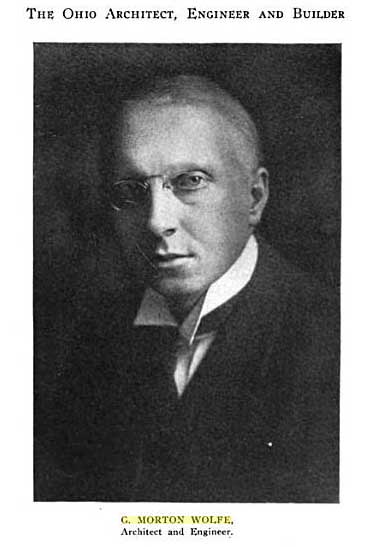![]()
Architects in Buffalo -
Table of Contents
G. Morton Wolfe
|
Mr. Wolfe, after graduating from Technical school, spent two years with one of the leading architects in Buffalo, worked as superintendent of construction for two years, took office work again as chief draftsman for several years, then entered the contracting field and erected buildings costing in excess of one Million Dollars. This was all in preparation and to gain experience in architectural engineering which Mr. Wolfe has followed for the past eight years in Buffalo. That he has been successful is indicated by the number of buildings he designed - aggregating in cost over three million dollars, principally of the industrial class. A selection of the various types of construction of his buildings is given in this issue. - Ohio
Architect and Builder, Volume 28, August, 1916 (online August 2017)
...
Includes an article on page 1, "The Factory Owner's Problem," by Wolfe,
as well as including his photograph, shown above.
|
Draft Nomination - National Register of Historic Places Parkside Candy Shoppe and Factory 3208 Main Street, Buffalo NY By Francis R. Kowsky and Martin Wachadlo [Edited by Jennifer Walkowski, NYSHPO] Preservation Studios The
Architect: G. Morton Wolfe
The architect of the Parkside Candy Company was a well-known figure in the Buffalo architectural profession in the first half of the twentieth century. G. Morton Wolfe was born in 1886 in Middletown, Connecticut, and settled in Buffalo in 1903. At the time, he began working for a local building concern. In 1908, he started his own architectural and engineering practice, building a reputation for the design of all sorts of buildings, especially industrial buildings and shopping centers. Residences in a variety of historical styles also came from his drawing board. Among his earliest independent works was the Spanish Revival Circle Arts Theater (1914) at 444 Connecticut Street (now a mosque). A later cinema, the Amherst Theater on Main Street near the Parkside Candy Company, was a major component of the University Plaza (mostly demolished) that Wolfe designed in 1942. Wolfe was also active in promoting the fortunes of the local architectural profession. In 1938, he organized the first professional association here, the Western New York Society of Architects. When this organization was superseded in 1944 by the Buffalo Western New York chapter of the American Institute of Architects, Wolfe became its first president. In 1949, Wolfe organized a committee of architects and engineers to revise Buffalo’s building code, which was then more than fifty years old. For eight years, his group worked pro bona to complete a new code. He also represented the AIA chapter in its efforts to improve relations between contractors, laborers, and architects. Wolfe retired from active practice in 1962; he died three years later. |
Wolfe graduated from Hartford High School, Hartford, Connecticut in 1905.
In 1919, Wolfe's address
is listed as 1377 Main St. Source: Electrical
world: a review of current progress in electricity and

